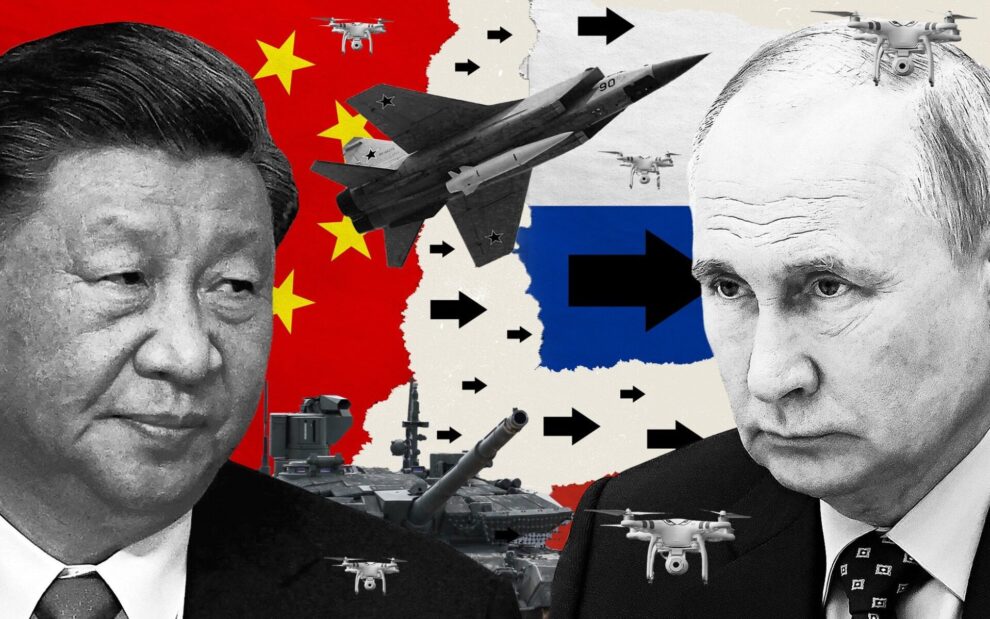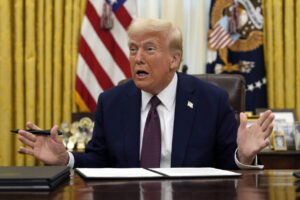Russian firms have received tens of thousands of Chinese shipments since the war in Ukraine began
China is helping to arm Russia with helicopters, drones, optical sights and crucial metals used by the defence industry, a Telegraph investigation has found.
Russian firms – including sanctioned companies – involved in the production of missile launchers, armoured vehicles, and strategic bombers, have received tens of thousands of shipments from China since Russia’s full-scale invasion of Ukraine began through the first quarter of this year.
It comes as China, which insists it remains neutral, is attempting to position itself as a key peace-broker in talks aimed at ending the conflict.
Trade between China and Russia is set to surpass $200 billion this year, a new record high, even as Chinese exports to other countries have fallen significantly.
Exports of goods with potential military uses rose by more than three times in the year which ended this June, compared to the one prior, according to analysis from the Observatory of Economic Complexity, a trade data visualiser.
Dual-use goods
Such goods are classified as dual-use, meaning they also have civilian purposes, allowing China to skirt international sanctions and claim that it conducts only legal trade with Russia. China’s support appears to be helping Russia weather sanctions, calling into question the effectiveness of a crucial part of the West’s campaign against Moscow aimed at crippling Russia’s economy.
One Chinese company sent 1,000 drones to Russia in the two months before the war, according to figures compiled by Molfar Global, an open source research organisation. That firm, Shantou Honghu Plastics, describes itself as a wholesaler of children’s toys on its website and social media profiles.
The drones were sent to a Russian firm called Samson, which similarly describes itself as a wholesaler of games and toys and appears to be a shell company, stating only 10,000 rubles in capital to its name, according to a public company registry.
Then, four days after war broke out in Ukraine, Chinese company Hems999 supplied two helicopters. Another Chinese firm, Tianjin Huarong Aviation, has transferred four Airbus helicopters to Russia since the war began.
All were received by Russian firm Ural Helicopter, whose primary customer is the Russian National Guard, deployed to Ukraine and led by Viktor Zolotov, a longtime bodyguard to Putin.
Chinese firms have also sent optical sights to more than 50 Russian companies from the start of 2022 through the first quarter of this year. Imports of these products nearly doubled to $2.5 million last year, compared to the one prior.
Yiwu Wojie Optics Instrument accounted for the majority of optical sights – about 2,500 – furnished to Russian firm CEK, which has previously supplied such goods and night vision equipment to the Russian internal affairs ministry, according to data pulled by Molfar from 52wmb, a Chinese trade data aggregator.
Invoices state such equipment is for “hunting,” though the devices could be fitted to military weapons, and offer enhanced vision for military operations.
Russian imports of raw materials soar
Chinese exports of turbojets and radar missile navigation systems have also been sent via India and Costa Rica before being re-exported to Russia, according to Molfar research, in an apparent effort to evade sanctions.
According to the trade data, Russia’s imports of raw materials and components vital for the manufacture of armaments have soared.
China exported $18 million of titanium alloy products to Russia in 2022, nearly double the year prior.
Lightweight and heat-resistant titanium alloys are a key material used to manufacture military aircraft and weapons.
Titanium plates and rods were shipped from China to NPP Start, a developer of air-defence missile launchers which is part of Russia’s Rostec defence conglomerate.
Titanium products have also been sent to S7 Technics, which performs aircraft maintenance and repair, and has done work for an organisation that oversees the air transport of Putin and other Kremlin officials.
S7 is also working to make aircraft spare parts so that Russian airlines can keep their fleets operational after sanctions cut off supplies of Western-made components for Airbus and Boeing planes.
Chinese companies also sent deliveries of magnesium alloys to Tupolev, which builds and helps maintain long-range bombers like the Tu-95 and Tu-160M, which have been used to launch cruise missile attacks on Ukraine.
https://cf-particle-html.eip.telegraph.co.uk/f38cdd9d-4123-496e-a2a4-24b51533a5da.html?i=0&ref=https%3A%2F%2Fwww.telegraph.co.uk%2Fworld-news%2F2023%2F08%2F19%2Fchina-helping-arm-russia-helicopters-drones-metals-xi-putin%2F&channel=Worldnews&id=f38cdd9d-4123-496e-a2a4-24b51533a5da&isapp=false&isregistered=false&issubscribed=false&truncated=false<=false
Companies linked to the production of Kamaz vehicles – whose armoured carriers, like the Kamaz Typhoon, transport Russian troops and cargo – have received at least 520 shipments from China.
Goods included spare parts, welding machines and laser machine tools that can be used for manufacturing weapons and military equipment.
Steel was sent by China to Russian firms involved in the production of, or make engines for, Kamaz armoured vehicles. One of Russia’s largest firms, Magnitogorsk Iron and Steel Works – which collaborates in making Kamaz vehicles – was amongst those receiving shipments, and has been sanctioned by the US and Ukraine.
Some of the Chinese firms, such as Wuxi Tianxing Steel and Xi’an Alpha Metal even have offices in Moscow or company websites in Russian, making little effort to hide their military links, splashing pictures of fighter jets and naval ships on their homepages.
Trade through back channels
China may also be supplying raw materials to Russia through back channels.
Beijing and Moscow, have reportedly held secret talks with Iran to supply ammonium perchlorate, a chemical compound used to propel ballistic missiles – a deal, if agreed, that would likely be hidden from official trade registers.
Russia has not published trade data since the invasion began, though figures from China, its top trading partner, indicate that Beijing has become a crucial lifeline, even as Putin has become ostracised on the world stage, and both Western companies and countries have cut ties with Moscow.
Xi Jinping the Chinese leader, has met Putin several times, including in the weeks before war broke out, but only agreed to one hour-long phone call with Volodymyr Zelensky, the Ukrainian president, in April.
Beijing issued a 12-point “peace statement” earlier this year that rehashed its position and did not propose any solutions to ending the war.
China participated in a second round of peace talks in Saudi Arabia on August 6, after opting against attending the first round earlier this year. It still refuses to describe what is happening in Ukraine as an “invasion”.
None of the companies replied to The Telegraph’s requests for comment. Some, such as CEK, could not be reached.
The Telegraph reviewed extensive data showing Chinese exports of materials to Russian defence contractors and military equipment manufacturers, since the start of 2022 through the first quarter of this year.
Findings are based on analysis of data obtained from OEC and Molfar.
Source : The Telegraph










